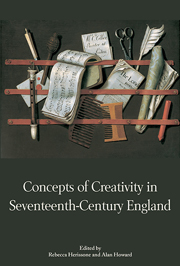Book contents
- Frontmatter
- Contents
- List of Illustrations
- List of Contributors
- Preface
- Introduction
- Creating to Order: Patronage and the Creative Act
- Creative Identity and the Role of Print Media
- Mapping Knowledge: The Visual Representation of Ideas
- Authorial Identity
- Imitation and Arrangement
- 9 A Meeting of Amateur and Professional: Playford's ‘Compendious’ Collection of Two-Part Airs, Court-Ayres (1655)
- 10 ‘Creating’ Cato in Early Seventeenth-Century England
- The Performer as Creator
- Bibliography
- Index
9 - A Meeting of Amateur and Professional: Playford's ‘Compendious’ Collection of Two-Part Airs, Court-Ayres (1655)
from Imitation and Arrangement
Published online by Cambridge University Press: 05 March 2014
- Frontmatter
- Contents
- List of Illustrations
- List of Contributors
- Preface
- Introduction
- Creating to Order: Patronage and the Creative Act
- Creative Identity and the Role of Print Media
- Mapping Knowledge: The Visual Representation of Ideas
- Authorial Identity
- Imitation and Arrangement
- 9 A Meeting of Amateur and Professional: Playford's ‘Compendious’ Collection of Two-Part Airs, Court-Ayres (1655)
- 10 ‘Creating’ Cato in Early Seventeenth-Century England
- The Performer as Creator
- Bibliography
- Index
Summary
The English two-part repertoire for treble and bass is perhaps best known from the various publications issued by John Playford in the second half of the seventeenth century, the first of which appeared as part of A Musicall Banquet (1651). The Banquet was obviously intended to gauge the potential market for printed music, and formed the blueprint for several of Playford's later publications. The volume was divided into four sections, as outlined on the title page:
The first Part presents you with Excellent new Lessons for the Lira Viol, set to severall New Tunings. The second a Collection of New and Choyce Allmans, Corants, and Sarabands for one Treble and Basse Viol, composed by Mr. William Lawes, and other Excellent Authours. The third Part containes New and Choyce Catches or Rounds for three or foure Voyces. To which is added some few Rules and Directions for such as learne to sing, or to play on the Viol.
The first section became Musicks Recreation: on the Lyra Viol, which went through four editions between 1652 and 1682; the third, Musick and Mirth, became Catch that Catch Can, published from 1652; and the fourth became A Breefe Introduction to the Skill of Mustek of 1654. Meanwhile the second section, Musica Harmonia, containing the two-part airs, was reissued in two substantially enlarged editions, Court-Ayres (1655) and Courtly Masquing Ayres (1662).
- Type
- Chapter
- Information
- Concepts of Creativity in Seventeenth-Century England , pp. 201 - 232Publisher: Boydell & BrewerPrint publication year: 2013



